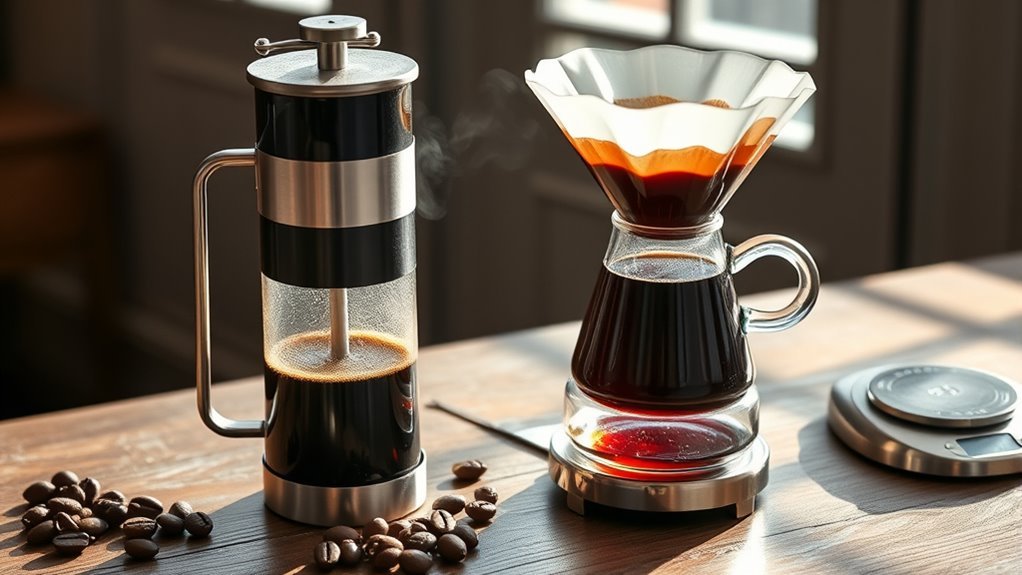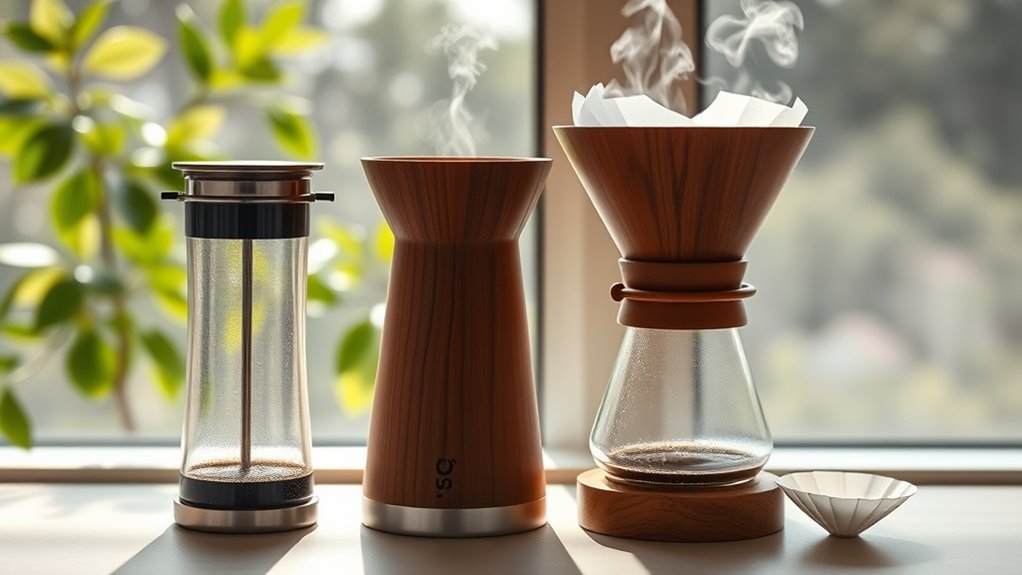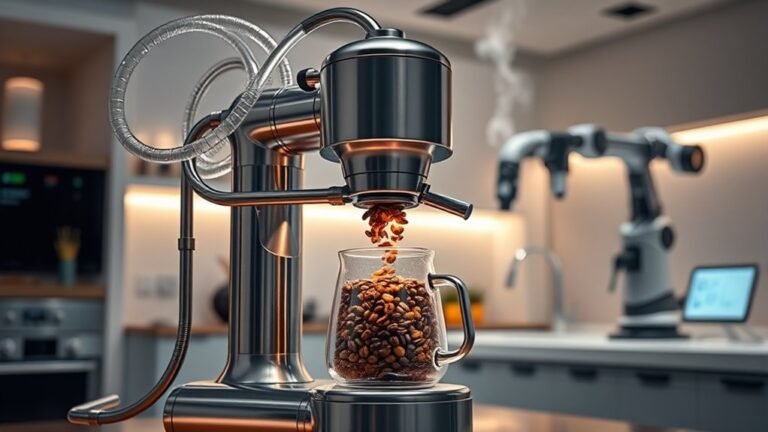Aeropress vs. Chemex: Which Brewing Method Is Right for You?
If you want a bold, intense cup with quick brewing (1.5–3 minutes) and portability, Aeropress is ideal—it uses pressure and fine grind for dynamic acidity and sweetness. Chemex suits you if you prefer a cleaner, nuanced flavor with a meditative 4–6-minute pour-over, emphasizing brightness via thick filters. Consider cost, cleanup, and customization: Aeropress offers budget-friendly, versatile control, while Chemex provides elegance with moderate recurring costs. Keep exploring to match method to your lifestyle and taste preferences.
Understanding the Aeropress Brewing Process

Although the Aeropress might seem straightforward, mastering its brewing process requires understanding how pressure, immersion time, and grind size interact to extract flavor compounds efficiently. You’ll want to experiment with these variables to control coffee extraction precisely. Using a fine to medium grind optimizes surface area, allowing rapid extraction during full immersion. Pressure applied during the plunge phase forces water through the grounds, enhancing extraction beyond simple immersion. Adjusting immersion time lets you balance acidity and bitterness, tailoring the profile to your preference. Unlike drip methods, Aeropress brewing techniques offer you freedom to tweak parameters dynamically, resulting in a concentrated, clean cup. By grasping these technical elements, you can consistently harness the Aeropress’s potential for producing complex, well-extracted coffee without sacrificing control.
Exploring the Chemex Brewing Technique
When using the Chemex, you’ll notice its proprietary thick paper filters greatly reduce oils and sediment, resulting in a cleaner cup. The pour-over technique requires precise control over water flow rate and temperature to optimize extraction and highlight nuanced flavors. Understanding these parameters is key to mastering the Chemex brewing process.
Chemex Filter Benefits
The Chemex filter’s design plays an essential role in the brewing process, markedly influencing the clarity and flavor profile of your coffee. Its exceptional filter thickness guarantees superior brew uniformity and flavor extraction by slowing water flow and trapping oils and sediment. Crafted from high-grade paper, these filters offer consistent brewing consistency and enhanced taste clarity. Plus, you have eco friendly options that reduce waste without compromising quality.
| Feature | Benefit |
|---|---|
| Filter Thickness | Improved flavor extraction |
| Paper Quality | Consistent brewing consistency |
| Eco Friendly Options | Sustainable, reduces environmental impact |
Pour-Over Brewing Process
Because precise control over water flow and temperature is critical, mastering the Chemex pour-over brewing technique demands careful attention to each step. You start by selecting an appropriate brewing ratio—often 1:15 to 1:17 coffee to water—to balance extraction and flavor. The Chemex filter’s density requires you to pre-wet it, eliminating paper taste and stabilizing temperature. Employing consistent pour over techniques, you pour water slowly in concentric circles, allowing the coffee bed to bloom and then extract evenly. Controlling the pour rate and water temperature (around 195–205°F) enables you to tailor body and acidity precisely. Unlike automated methods, this manual approach grants you freedom to adjust variables dynamically, ensuring a clean, nuanced cup that reflects your exact preferences.
Flavor Profiles: Aeropress vs. Chemex
When comparing Aeropress and Chemex, you’ll notice distinct differences in taste intensity and flavor clarity. The Aeropress typically produces a bolder cup with pronounced acidity and sweetness, while the Chemex offers exceptional cleanliness and nuanced brightness. Understanding these contrasts helps you select the method that aligns best with your preferred flavor profile.
Taste Intensity Comparison
Although both Aeropress and Chemex extract coffee differently, you’ll notice distinct variations in taste intensity that stem from their unique brewing processes. Your taste preferences heavily depend on the brewing techniques: Aeropress uses pressure to intensify extraction, delivering a bold, concentrated cup, while Chemex employs gravity and a thicker filter, producing a lighter, more delicate flavor.
| Brewing Method | Taste Intensity | Typical Flavor Notes |
|---|---|---|
| Aeropress | High | Rich, bold, full-bodied |
| Chemex | Moderate | Smooth, subtle, nuanced |
If you favor a strong, robust profile, Aeropress suits you best. For a gentler, refined experience, Chemex aligns with your palate. Understanding these contrasts helps you tailor your brew to your desired intensity.
Clarity and Cleanliness
While both Aeropress and Chemex produce clean cups, the mechanisms behind their clarity differ greatly. The Chemex’s thick, bonded paper filters trap most oils and fine sediments, delivering exceptional flavor clarity and a bright, refined cup. This method emphasizes a lighter brew strength due to slower extraction and lower pressure, letting subtle notes shine without muddiness. In contrast, the Aeropress uses a microfilter combined with pressure-driven immersion, allowing you to control brew strength by adjusting grind size, water temperature, and plunge speed. This results in a clean cup with moderate body, though slightly less crystalline than Chemex. If you crave precise flavor clarity paired with customizable brew strength, Aeropress offers versatility, while Chemex excels at producing consistently pristine, delicate profiles with minimal sediment.
Acidity and Sweetness Levels
Acidity and sweetness are critical dimensions that distinguish the flavor profiles of Aeropress and Chemex brews. With the Aeropress, you gain precise control over extraction time and pressure, allowing you to fine-tune the acidity balance to your preference—often yielding a brighter, more pronounced acidity with moderate sweetness levels. Conversely, the Chemex’s thicker filter and longer pour-over process naturally moderate acidity, softening sharp notes and enhancing inherent sweetness levels, producing a smoother cup. If you seek a crisp, vibrant acidity balance, the Aeropress offers dynamic adjustments. But if you prioritize nuanced sweetness levels with gentle acidity, Chemex delivers a more refined, balanced experience. Understanding these differences empowers you to select a method that aligns with your flavor freedom and palate preferences.
Brewing Time and Convenience Comparison
Because brewing time directly impacts your daily routine, comparing the Aeropress and Chemex requires a close look at their respective processes and overall convenience. The Aeropress excels in brewing efficiency, typically delivering a cup within 1.5 to 3 minutes, thanks to its rapid immersion and pressure-driven extraction. This allows you to optimize time management, especially during busy mornings. On the other hand, the Chemex demands a more deliberate pour-over technique, extending brew time to around 4 to 6 minutes. While this slower process requires patience, it offers precise control over extraction variables. If freedom in your schedule is paramount, the Aeropress’s quick turnaround offers superior convenience. However, if you prefer a meditative brew ritual that fits flexible pacing, the Chemex’s longer brew time might align better with your lifestyle.
Equipment and Accessories Needed for Each Method

Choosing between the Aeropress and Chemex means considering not just brewing time but also the specific equipment and accessories each method requires. With Aeropress accessories, you’ll need the device itself, paper or metal filters, a stirring paddle, and a funnel for easy transfer of grounds. Its compact design limits the number of additional tools, emphasizing simplicity and minimalism. In contrast, Chemex supplies encompass the iconic glass carafe, proprietary bonded paper filters that are thicker than standard ones, a wooden collar with leather tie for handling, and a gooseneck kettle for precision pouring. The Chemex’s equipment demands a more deliberate setup, designed for clarity in flavor extraction. Your choice hinges on whether you value the Aeropress’s streamlined toolkit or the Chemex’s ritualistic array of specialized supplies.
Portability and Ease of Cleaning
When considering portability, you’ll find the Aeropress considerably more compact and lightweight compared to the glass and wooden components of the Chemex. Cleaning the Aeropress is also more straightforward, as its parts disassemble easily and require only a quick rinse, unlike the Chemex, which demands careful handling to avoid damage and thorough cleaning of its larger filter and carafe. Evaluating these factors will help you determine which method fits better into your daily routine or travel needs.
Portability Comparison
Both the Aeropress and Chemex are designed with portability in mind, but they differ considerably in size, weight, and cleaning complexity. The Aeropress boasts a compact design, weighing just around 3.8 ounces, making it highly travel friendly and easy to pack in your bag without adding bulk. Its durable plastic construction resists breakage, ideal for outdoor use or frequent travelers seeking freedom in brewing. Conversely, the Chemex is larger and made of fragile glass, increasing its weight and vulnerability during transport. While its elegant design appeals to stationary use, it’s less suited for rugged travel. If portability and ease of carrying are priorities, the Aeropress’s compact design and robust build clearly offer more freedom and convenience for on-the-go brewing.
Cleaning Process Differences
Beyond portability, the cleaning process substantially influences your overall experience with the Aeropress and Chemex. The Aeropress demands a higher cleaning frequency due to its compact design and multiple components, including the plunger, filter cap, and chamber. You’ll need basic cleaning tools like a sponge or brush to remove coffee residues from its narrow parts efficiently. Conversely, the Chemex features a simpler, one-piece glass carafe that requires less frequent cleaning but demands careful handling to avoid damage. Cleaning tools here are minimal—usually just a soft brush or cloth for thorough rinsing. Ultimately, if you prioritize quick disassembly and routine maintenance, the Aeropress suits you. But if you prefer minimal cleaning interventions with delicate care, the Chemex offers freedom from constant upkeep.
Cost Considerations for Aeropress and Chemex
Several factors influence the overall cost of owning an Aeropress or Chemex, ranging from initial purchase price to ongoing expenses like filters and maintenance. When you analyze the cost breakdown, the Aeropress typically has a lower upfront cost, often under $40, while Chemex models start around $40 and can exceed $100 for premium versions. However, Aeropress uses inexpensive, reusable filters or paper filters with minimal replacement costs, contributing to long term savings. Chemex relies on proprietary paper filters, which add recurring expenses. Maintenance costs are minimal for both but factor in filter availability and durability. If you value budget control and minimal recurring expenses, Aeropress offers more financial freedom. Conversely, Chemex’s higher initial investment and consistent filter costs might appeal if you prioritize aesthetic and pour-over precision despite added costs.
Customization and Experimentation Possibilities
Understanding cost differences gives you a foundation, but the real appeal of Aeropress and Chemex lies in how much control you have over brewing variables. With the Aeropress, you can manipulate steep time, pressure, grind size, and water temperature for extensive flavor experimentation. The Chemex offers control mainly through grind size and pour rate, enabling nuanced brew variations that highlight clarity and brightness.
| Feature | Aeropress | Chemex |
|---|---|---|
| Brew Time | 1-3 minutes | 4-5 minutes |
| Pressure Control | Manual pressure adjustment | Gravity drip only |
| Grind Size Range | Fine to medium-coarse | Medium to coarse |
| Flavor Profile Range | Wide, from strong to mild | Clean, delicate |
You’ll find the Aeropress more versatile for bold experiments, while Chemex excels at consistent, clean brews.
Environmental Impact and Sustainability Factors

While both the Aeropress and Chemex deliver quality coffee, their environmental footprints differ markedly due to materials, waste generation, and energy use. The Aeropress primarily utilizes durable plastic components, which, although not biodegradable, offer longevity that supports waste reduction through repeated use. Its paper filters are compostable, aligning with sustainable materials practices. Conversely, the Chemex’s construction from glass—a fully recyclable and inert material—enhances sustainability, but it relies on proprietary paper filters that contribute to disposable waste streams. Energy consumption also varies; the Aeropress requires minimal water heating time due to its small volume, whereas the Chemex demands larger water quantities and longer heating periods, impacting overall energy efficiency. If minimizing environmental impact is your priority, consider how these factors align with your commitment to sustainable materials and waste reduction.
Choosing the Best Method Based on Your Lifestyle
How do your daily routines and preferences influence the choice between Aeropress and Chemex? Your lifestyle preferences dictate the best brewing method. If you value speed and portability, the Aeropress suits dynamic routines, delivering a robust cup within minutes, ideal for busy mornings or travel. Conversely, the Chemex aligns with a more deliberate, ritualistic pace, emphasizing clarity and flavor complexity, perfect if your routine allows time for slow extraction. Consider your workflow: Aeropress offers convenience and versatility, adapting to varied water sources and grind sizes, supporting on-the-go freedom. Chemex demands precise temperature control, coarser grind consistency, and patience, rewarding those who savor the process as much as the product. Ultimately, analyzing how your daily routines and lifestyle preferences intersect with these technical demands guarantees you select a method that complements your desired freedom and coffee experience.
Frequently Asked Questions
Can I Use the Same Coffee Grind Size for Both Aeropress and Chemex?
You shouldn’t use the same grind size for both because each demands different extraction. The Chemex needs a coarser grind for ideal brew time and clarity, while the Aeropress thrives with medium-fine grinds, offering brewing versatility. Maintaining grind consistency is key regardless, as it affects flavor extraction. You’ve got the freedom to experiment, but adjusting grind size tailored to each method guarantees you get the best flavor profile out of your coffee.
Which Method Is Better for Making Iced Coffee?
When making iced coffee, you’ll find Aeropress offers superior brewing efficiency and versatility with various iced coffee techniques. Its rapid extraction and ability to control steep time prevent dilution, preserving flavor intensity. Chemex’s slower drip process can result in a less concentrated brew, often requiring adjustments. If you want freedom in flavor control and faster iced coffee prep, Aeropress generally performs better technically for iced coffee enthusiasts.
Are There Any Health Benefits Specific to Aeropress or Chemex Coffee?
Imagine sipping coffee with a pocket watch in hand—timeless and precise. When it comes to health, you’ll find Chemex coffee tends to have higher antioxidant content due to its thick paper filter, which also traps diterpenes linked to elevated cholesterol levels. Aeropress, however, uses a finer filter that allows more oils through, possibly impacting cholesterol differently. Understanding these nuances helps you choose a brew that aligns with your health goals and desire for informed freedom.
Can I Brew Tea Using Aeropress or Chemex?
You absolutely can brew tea using an Aeropress or Chemex. Both devices excel at controlled tea infusion, allowing precise temperature and steep time adjustments. The Aeropress’s pressure-driven extraction enhances flavor extraction quickly, while the Chemex’s thick filter provides a clean, nuanced cup by slowing infusion. You’ve got freedom to experiment with leaf quantity, grind size, and water temperature, tailoring your brew’s strength and clarity exactly to your taste preferences.
How Do Water Temperature Variations Affect Each Brewing Method?
Imagine your coffee as a symphony, where water temperature is the conductor shaping each note. When you tweak the temperature, you directly affect brew time and extraction efficiency—higher temps speed extraction, risking bitterness, while lower temps prolong brew time, possibly under-extracting flavors. You’re free to experiment: in shorter brew methods, precise temperature control hones clarity; in longer ones, it balances complexity. Mastering this dance lets you craft coffee exactly how you want it.






